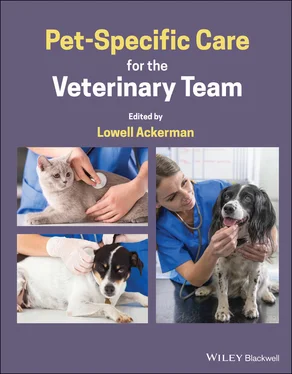Donna L. Harris, DVM, MBA, MS(Strategic Foresight)Veterinary Special Services, College of Veterinary Medicine, Michigan State University East Lansing, MI, USA harrisko@msu.edu vssmich@sbcglobal.net
David Haworth, DVM, PhDPresident, Vidium Animal Health, Phoenix, AZ, USA vidiumah.com
Brandon Hess, CVPM, CCFPVetSupport Inc., Cincinnati, OH, USA Brandon@vetsupport.com www.vetsupport.com
Alicea Howell, LVT, VTS (Behavior), KPA, CTPOwner, Barks and Rec Animal Training and Behavior, Traverse City, MI, USA www.BarkRanger.net
Jessica Johnson, DVMMain Street Veterinary Dental Clinic, Flower Mound, TX, USA
Anna Katogiritis, BSc, DVMIndependent SA and Wildlife Emergency Veterinarian and NGO Consultant www.DoctorAnnaK.com DoctorAnnaK@gmail.comSocial media:@DoctorAnnaK
Kim Kendall, BVSc, MANZCVS (Cat Medicine and Animal Behaviour)Clinical cat veterinarian and behavioural consultant, Roseville, NSW, Australia www.felinefriendlycare.com
Chand Khanna, DVM, PhD, DACVIM (Onc), DACVP (Hon)Veterinary Oncologist and Chief Science Officer, Ethos Veterinary Health, Woburn, MA, USA ckhanna@ethosvet.com
Patricia Khuly, VMD, MBAIndependent veterinary journalist and owner, Sunset Animal Clinic, Miami, FL, USA khulyp@bellsouth.net
Jacqui Ley, BVSc (Hons), PhD, DECAWBM, FANZCVS (Veterinary Behaviour)Registered Specialist in Veterinary Behaviour, Melbourne Veterinary Specialist Centre, Glen Waverley, Victoria, Australia behaviour@melbvet.com.au
Heidi B. Lobprise, DVM, DAVDCMain Street Veterinary Dental Clinic, Flower Mound, TX, USA HeidiDent93@gmail.com
Mark J. Mcgaunn, CPA/PFS, CFP®McGaunn & Schwadron, CPA’s, LLC, Medfield, MA, USA www.mcgaunnschwadron.com
Brennen Mckenzie, MA, MSc, VMDAdobe Animal Hospital, Los Altos, CA, USA www.skeptvet.com
Emma Goodman Milne, BVSc, MRCVSIndependent Veterinary Surgeon www.vetsagainstbrachycephalism.com
Jason C. Nicholas, BVETMED (Hons)Independent Consultant, Author and Speaker, Co‐founder, Preventive Vet www.DrJasonNicholas.comwww.linkedin.com/in/drjasonnicholas DrJVet1@gmail.com
Anita M. Oberbauer, PhDProfessor and Associate Dean, Department of Animal Science, University of California, Davis, CA, USA amoberbauer@ucdavis.edu
Kurt A. Oster, MS, SPHR, SHRM‐SCPBay State Veterinary Emergency and Specialty Services, Swansea, MA, USA www.kurtoster.com
Joanna Pendergrass, DVMFreelance Medical Writer Founder and owner, JPen Communications, LLC, Sandy Springs, GA, USA www.jpencmc.com joanna@jpencmc.com
Saya Press, BVSc, MS, DACVECCThe Veterinary Specialty Hospital of San Diego, Sorrento Valley, San Diego, CA, USA spress@ethosvet.com
I. Craig Prior, BVSc, CVJIndependent Consultant, Lecturer, and Practitioner, College Grove, Brentwood, TN, USA ausivet@gmail.com
Krystle L. Reagan, DVM, PhD, DACVIM (SAIM)Assistant Professor, Department of Veterinary Medicine and Epidemiology, Small Animal Infectious Disease Fellow, School of Veterinary Medicine,University of California, Davis, CA, USA kreagan@ucdavis.edu
Sarah RumpleVeterinary Writer and Editor, Owner and Chief Creative Officer of Rumpus Writing and Editing LLC, Denver, CO, USA rumpuswriting.com
Suzanne Russo, DVM, MSAssociate Dean of Clinical Education, College of Veterinary Medicine, Midwestern University, Glendale, AZ, USA osudvm92@gmail.com
Robert SanchezCEO, Digital Empathy, San Diego, CA, USA digitalempathyvet.com
Kymberley C. McLeod, DVMConundrum Consulting, Toronto, Ontario, Canada kymberley‐stewart@idexx.com
Samuel Stewart, DVM, DACVECCVeterinary criticalist and commercialization scientist, Ethos Veterinary Health, Woburn, MA, USA sstewart@ethosvet.com
Natalie Stilwell, DVM, MS, PhDSoutheastern Cooperative Wildlife Disease Study, College of Veterinary Medicine, University of Georgia, Athens, GA, USA nkstilwell@gmail.com
Jane Sykes, BVSc, PhD, DACVIM (SAIM)Chief Veterinary Medical Officer and Professor, Department of Veterinary Medicine and Epidemiology, School of Veterinary Medicine, University of California, Davis, CA, USA jesykes@ucdavis.edu
Lori Massin Teller, DVM, BS (Vet Sci), DABVP (Canine/Feline Practice)Clinical Associate Professor, Telehealth, Department of Small Animal Clinical Sciences, College of Veterinary Medicine & Biomedical Sciences, Texas A&M University, College Station, TX, USA http://vetmed.tamu.edu
Cindy Trice, DVMFounder/CEO, Relief Rover, Bradenton, FL, USA reliefrover.com
Ernie Ward, DVM, CVFT (Certified Veterinary Food Therapist)Founder, Association for Pet Obesity Prevention, Ocean Isle Beach, NC, USA PetObesityPrevention.org DrErnieWard.com
Linda Wasche, MBA, MALW Marketworks, Inc., Sylvan Lake, MI, USA Lindaw@LWmarketworks.com www.LWmarketworks.com
Peter Weinstein, DVM, MBAPAW Consulting, Irvine, CA, USA PeterWeinsteinDVMMBA@gmail.com
This book was designed to provide a valuable resource for all things related to pet‐specific care, from prevention, to early detection, to evidence‐based treatment, guidelines, and facilitated compliance. It is an appropriate source of information to foster consensus building and a team approach to delivering excellent healthcare to animals.
The concept of pet‐specific care is relatively new in veterinary medicine (while the equivalent “personalized medicine” is now considered de rigueur in human medicine) and involves selecting appropriate services for pet and owner, based on both subjective and objective criteria, including breed predisposition, age, level of care requested by owner, risk assessment, appropriate guidelines, financial considerations, and many more aspects. While much of veterinary medicine has been reactive in the past, waiting for pets to develop problems before veterinary teams got involved, pet‐specific care is more proactive, focuses on keeping pets healthy, and considers approaches that span a lifetime rather than from one veterinary visit to the next. It also involves managing pets in a truly team‐based fashion, so throughout the book emphasis is given to the roles of team members in delivering excellent healthcare, communication, and client service. In addition to specific topics covered within the book, there is also a rich collection of appendices that provide additional resources, abbreviations, glossary, and breed tables of heritable conditions organized by canine and feline breeds, conditions, and breed attributes.
Whether you want to know how to provide genetic testing and counseling in practice, find out more about guidelines and standards of care, or the meaning of the term “incremental care” as it applies to healthcare options for clients who couldn't otherwise afford services, you'll find it within the pages of this book.
The intention is to provide as much information as is available that pertains to pet‐specific care for both dogs and cats, and that can be somewhat challenging because there tend to be more resources in the veterinary literature on dogs than cats. That does not detract from the importance of cats and their owners, but recognizes that at this time there are more guidelines, genetic tests, and conditions recognized with a breed predisposition in dogs versus cats. Still, every effort has been made to include as many feline resources as possible, including topics primarily or exclusively dedicated to cats. This isn't just a nod to practices dedicated to cats. In many countries, the majority of pets are cats, and yet cats often represent a much smaller percentage of office appointments and often significantly less hospital revenue. Thus, improving pet‐specific care for cats and their owners also represents a major opportunity for veterinary practices. Most of the content of this book applies equally to cats as to dogs, and there are additional cat‐specific topics in the book as well. It is a sincere hope that there will be even more feline resources available in future editions as the profession develops more of such content because everyone (practices, pet owners, and cats themselves) will benefit from such developments.
Читать дальше












